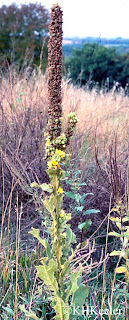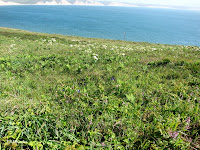 |
| common mullein Verbascum thapsus, in late summer |
The name mullein may be from mollis, Latin for soft, a description of the big hairy leaves, but it is possibly from the Latin malandrium, a disease of cattle, for which mullein was a remedy. There are several points of confusion about common mullein (see below). But clearly it has been known so long that its common name is based on Latin.
Pliny called the plant verbascum, so apparently that was another name Latin speakers used. Linnaeus adopted Verbascum as the scientific name for the genus.
The word, thapsus, is the name of a town in north Africa, now Ras Dimas, Tunisia. On April 6, 46 BC, Julius Caesar defeated the forces of Scipio at Thapsus. The battle was fought on the outskirts of the city and the city surrendered shortly thereafter, ending the war against Caesar in Africa. However, when I tried to figure out if that meant that mullein grows in Tunisia, I discovered that en.wikipedia says, convincingly, that thapsus was taken from thapsos, the name of an unidentified plant from Thapsos in Sicily. As far as I can tell the plant has been growing in both areas since prehistoric times. I doubt that it is native to all of Eurasia as the en.wikipedia article says. More probably, long before written history it migrated with humans to all those locations, from some much more limited homeland.








